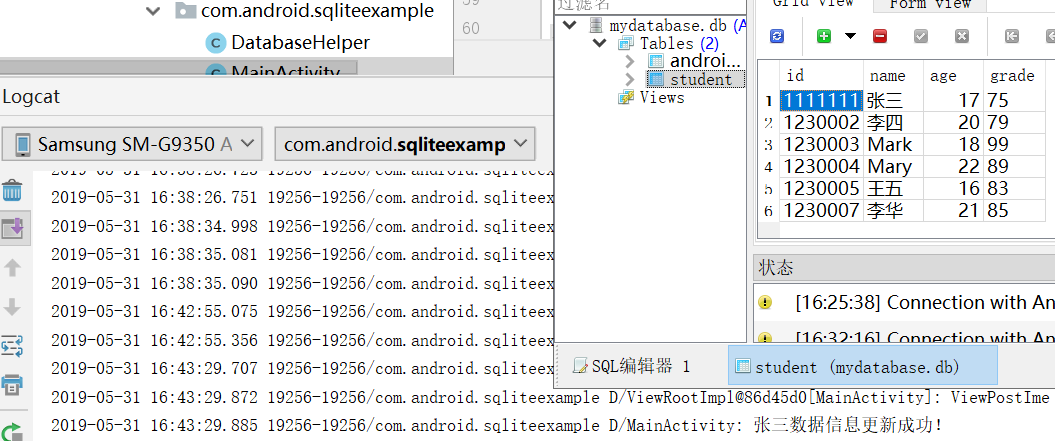

- #Sqlitestudio databases how to
- #Sqlitestudio databases install
- #Sqlitestudio databases code
- #Sqlitestudio databases series
If you use LibreOffice, follow the provided document showing you how to perform the steps described in the videos.

You're now going to transform your Excel file to match the latest version of the relational model provided above.Įven though Excel and LibreOffice Calc are very similar, there are a few differences you need to know before watching the videos. Adapt Your CSV to Fit the Relational Model
#Sqlitestudio databases code
Here’s the SQL code for the PDM, which flows from the relational schema and is compatible with the SQLite3 RDBMS. So, here’s your adapted relational model after correcting the issues mentioned above and adding artificial keys: Latest version of the relational model

However, don’t be surprised if you see the opposite happening in the work world, as good practices are rarely adopted. The PDM flows directly from the relational model (LDM).Īt the end of the chapter “Determine Your Primary Keys,” we discussed only using artificial keys in your LDM in specific cases, but you are encouraged to use them in all tables for the PDM. The PDM is highly dependent on the chosen RDBMS because each has its own variant of SQL and different features. Next, you need to develop the physical data model (PDM). To resolve the second point, remove the season attribute from the production table, meaning that you’ll lose this piece of information. It also means that the association between shooting_period and director will turn into a one-to-many relationship (instead of many-to-many). So, the name attribute in the director will no longer be atomic, which will violate the 1NF. To resolve the first point, allow director to hold a pair of directors in the same row. It’s a shame because it will impact the quality, but it will make it much simpler for you. Instead, we’re going to change the relational model. When this happens, you need to look at the filming date for each series, which would take too long.
#Sqlitestudio databases series
Either way, it's too tricky.įor series productions, the season number is often missing. You either need to check thousands of rows by hand and separate the pairs to resolve this or create a formula that will do it automatically. However, the director table can only have one director per row in your relational model. The Director column in your file is multivalued (i.e., some rows contain pairs of directors). Some data cleansing activities will be simple, while others are complex. So you first need to go through a process of data cleansing. You’ve created a high-quality relational model, so well done!īut the data you have available isn’t particularly high quality, and you're about to find out why. Adapt Your Relational Model and Create the PDM It would be mean (but true) to say at this point that all you've done is a couple of drawings your database doesn't exist yet! But thankfully, by the end of this chapter, you’ll have an actual database that you can query using SQL. You've worked hard to create your CDM and LDM. In closing, SQLiteStudio comes in handy for users who need to manage and alter SQLite databases by inserting new tables, views, triggers and indexes.We’re almost at the end of the course. In this manner, you can view specific information from each table, or gather data from multiple tables using INNER JOIN statements.Īlso, you can add a new trigger for the selected database by specifying its name, choosing its action, then writing the proper code. In case you want to insert a new table in the existing database, you need to choose the proper options, then specify the table name, set table constraints and add as many columns as you want.īy using the ‘SQL query editor’ option, located in the Tools menu, you are able to manually create your SQL scripts and execute them. The Tables menu allows you to erase data, as well as create a new table and populate it by specifying the number of rows you want to add. After that, you can view all the existing data and manipulate it the way you want. Additionally, you can import schema from other databases or from various file formats such as CSV and dBase.

The hierarchical tree view allows you to select any table, trigger, procedure or statement and view the data in the main window.įrom the ‘Databases’ menu you are able to open a new *.db, *.sdb, *.sqlite or *.db2 file and connect to it using the right-click menu. The left panel displays all of the available databases along with their data.
#Sqlitestudio databases install
Since it does not require you to install it, all you have to do is to double-click the installer and start managing your SQLite databases effortlessly. The application comes with an intuitive interface and well-organized menus. SQLiteStudio is a comprehensive and reliable SQLite database manager that provides you with a simple means of managing the contents of each database, including tables, triggers and views.


 0 kommentar(er)
0 kommentar(er)
